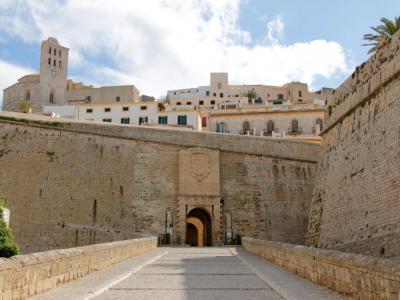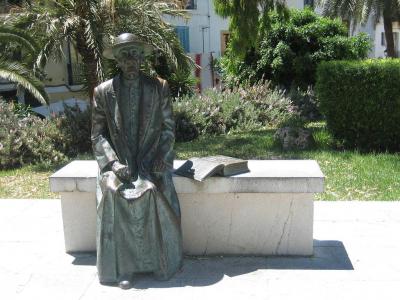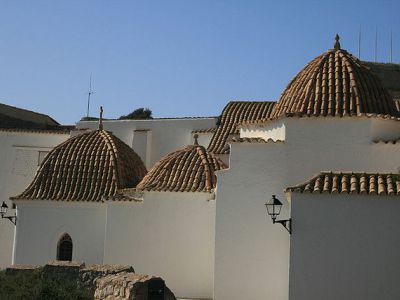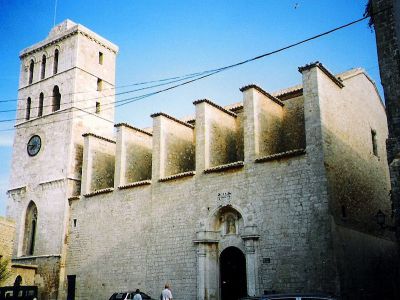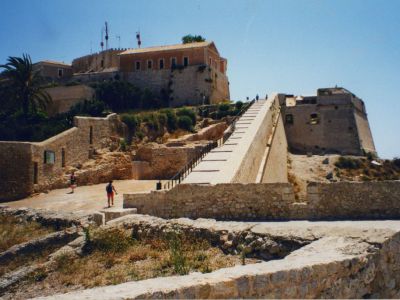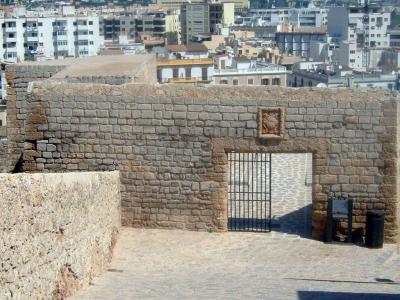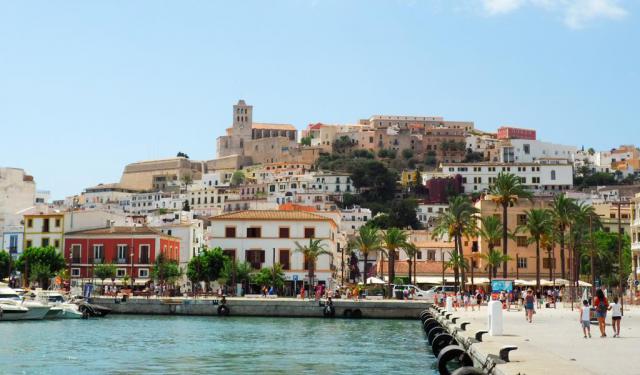
Ibiza City Introduction Walk (Self Guided), Ibiza
The town of Ibiza is the capital of the homonymous island in the Spanish Balearic archipelago.
The vast history of the island stretches all the way back to 654 BC, when Phoenicians established here a natural-bay port. This port was called Ibossim (or Iboshim, “the city of Bes”) in dedication to the god of music and dance (the legacy still very much present here today). Later, it became known to the Romans as Ebusus, until eventually adopting the Catalan name Eivissa (restored as the official name in 1986) and its derivative in English and Spanish – Ibiza.
After falling under Carthaginian control, the town/island emerged as a major producer of dye, salt and wool, and subsequently as a trading post, one of the largest on the Mediterranean routes. Following the destruction of Carthage in 146 BC, the city maintained its political and commercial autonomy, until falling into the period of decline that lasted almost the entire Roman imperial phase, followed by the arrival of the Vandals in 424, and the subsequent occupation by the Byzantines and Arabs.
The medieval period saw the area of Dalt Vila (literally "Upper Town") fortified by Spanish King Felipe II to protect the city from attacks by the Ottomans and pirates. Today, these fortifications are among of the best-preserved in Europe – listed as a UNESCO Heritage Site since 1999. Among them are the Ses Taules Gateway – built in 1585, and St. Pere Bastion – doubles as an outdoor theater. Also stands out from that period is a 13th-century landmark – the Cathedral of Saint Mary.
Ibiza became world-famous in the 1960s, thanks to the hippie movement, with many youngsters coming to enjoy local beaches, nightlife, and shopping. The more modern Ibizan attractions include: Contemporary Art Museum of Ibiza – opened in 1969, one of the oldest contemporary art museums in Spain; and Vara del Rey Walkway – arguably the most famous promenade on the island.
Indeed, a holiday in Ibiza can involve a lot more than just throwing shapes and soaking up the sun. To see for yourself the cutting-edge galleries, fascinating historical sites and eerie caves of Ibiza, take this self-guided walking tour.
The vast history of the island stretches all the way back to 654 BC, when Phoenicians established here a natural-bay port. This port was called Ibossim (or Iboshim, “the city of Bes”) in dedication to the god of music and dance (the legacy still very much present here today). Later, it became known to the Romans as Ebusus, until eventually adopting the Catalan name Eivissa (restored as the official name in 1986) and its derivative in English and Spanish – Ibiza.
After falling under Carthaginian control, the town/island emerged as a major producer of dye, salt and wool, and subsequently as a trading post, one of the largest on the Mediterranean routes. Following the destruction of Carthage in 146 BC, the city maintained its political and commercial autonomy, until falling into the period of decline that lasted almost the entire Roman imperial phase, followed by the arrival of the Vandals in 424, and the subsequent occupation by the Byzantines and Arabs.
The medieval period saw the area of Dalt Vila (literally "Upper Town") fortified by Spanish King Felipe II to protect the city from attacks by the Ottomans and pirates. Today, these fortifications are among of the best-preserved in Europe – listed as a UNESCO Heritage Site since 1999. Among them are the Ses Taules Gateway – built in 1585, and St. Pere Bastion – doubles as an outdoor theater. Also stands out from that period is a 13th-century landmark – the Cathedral of Saint Mary.
Ibiza became world-famous in the 1960s, thanks to the hippie movement, with many youngsters coming to enjoy local beaches, nightlife, and shopping. The more modern Ibizan attractions include: Contemporary Art Museum of Ibiza – opened in 1969, one of the oldest contemporary art museums in Spain; and Vara del Rey Walkway – arguably the most famous promenade on the island.
Indeed, a holiday in Ibiza can involve a lot more than just throwing shapes and soaking up the sun. To see for yourself the cutting-edge galleries, fascinating historical sites and eerie caves of Ibiza, take this self-guided walking tour.
How it works: Download the app "GPSmyCity: Walks in 1K+ Cities" from Apple App Store or Google Play Store to your mobile phone or tablet. The app turns your mobile device into a personal tour guide and its built-in GPS navigation functions guide you from one tour stop to next. The app works offline, so no data plan is needed when traveling abroad.
Ibiza City Introduction Walk Map
Guide Name: Ibiza City Introduction Walk
Guide Location: Spain » Ibiza (See other walking tours in Ibiza)
Guide Type: Self-guided Walking Tour (Sightseeing)
# of Attractions: 11
Tour Duration: 2 Hour(s)
Travel Distance: 2.8 Km or 1.7 Miles
Author: Caroline
Sight(s) Featured in This Guide:
Guide Location: Spain » Ibiza (See other walking tours in Ibiza)
Guide Type: Self-guided Walking Tour (Sightseeing)
# of Attractions: 11
Tour Duration: 2 Hour(s)
Travel Distance: 2.8 Km or 1.7 Miles
Author: Caroline
Sight(s) Featured in This Guide:
- Puerto de Ibiza (Port of Ibiza)
- Portal de ses Taules (Ses Taules Gateway)
- Contemporary Art Museum of Ibiza
- Isidor Macabich Statue
- St. Vincent and St. James Church and Convent
- Saint Mary of Ibiza Cathedral
- Castle of Ibiza
- Plaza del Sol (Sun Square)
- Baluard de Sant Pere (St. Pere Bastion)
- Monographic Museum of Puig des Molins
- Paseo de Vara del Rey (Vara del Rey Walkway)
1) Puerto de Ibiza (Port of Ibiza) (must see)
The Port of Ibiza, located on the eastern side of the island of Ibiza, is a key gateway connecting the Balearic archipelago to mainland Spain and other neighboring islands. Famous for its lively atmosphere and strategic position, the port serves as both a commercial hub and a tourist magnet, catering to ferry passengers, cruise ships, and private yachts. It provides direct ferry connections to Spanish cities such as Dénia, Valencia, Barcelona, and Gandia, as well as to the islands of Formentera and Palma de Mallorca.
Arriving by sea at the Port of Ibiza offers a breathtaking view of the historic Dalt Vila, a UNESCO World Heritage Site since 1999. The city’s silhouette, dominated by the sobriety of its cathedral and surrounded by Renaissance walls, contrasts with the cosmopolitan and vibrant ambiance of the harbor below. The port’s setting is enriched by Ibiza’s maze-like old town streets, making it a fascinating blend of history and modernity.
The port has distinct areas: the Botafoc breakwater in the north for large cruise ships and fuel tankers, and the southern and western parts for ferry terminals, fishing docks, and marinas. The main ferry station, Maritime Station (Estació Marítima), handles passenger arrivals. Nearby is the Monument to the Corsairs, honoring local sailors who defended Ibiza’s shores. The northern marinas, Eivissa Nova and Marina Botafoc, offer 1,400 moorings and attract luxury yachts, enhancing the port’s reputation.
Ibiza’s port dates back to its origins as a Carthaginian colony in 650 BC and later became a Roman confederate city. While its maritime role was recognized in antiquity, the first port facilities were recorded in the 17th century. Major modern development began in the early 20th century and has expanded significantly in recent decades.
Today, the Port of Ibiza is a cultural landmark and lively social spot. Stretching through the historic La Marina and Sa Penya neighborhoods, it’s lined with bars, restaurants, and shops that showcase the island’s eclectic vibe. A perfect blend of tradition and modern trends, the port is a must-see for visitors arriving by ferry or exploring on foot.
Arriving by sea at the Port of Ibiza offers a breathtaking view of the historic Dalt Vila, a UNESCO World Heritage Site since 1999. The city’s silhouette, dominated by the sobriety of its cathedral and surrounded by Renaissance walls, contrasts with the cosmopolitan and vibrant ambiance of the harbor below. The port’s setting is enriched by Ibiza’s maze-like old town streets, making it a fascinating blend of history and modernity.
The port has distinct areas: the Botafoc breakwater in the north for large cruise ships and fuel tankers, and the southern and western parts for ferry terminals, fishing docks, and marinas. The main ferry station, Maritime Station (Estació Marítima), handles passenger arrivals. Nearby is the Monument to the Corsairs, honoring local sailors who defended Ibiza’s shores. The northern marinas, Eivissa Nova and Marina Botafoc, offer 1,400 moorings and attract luxury yachts, enhancing the port’s reputation.
Ibiza’s port dates back to its origins as a Carthaginian colony in 650 BC and later became a Roman confederate city. While its maritime role was recognized in antiquity, the first port facilities were recorded in the 17th century. Major modern development began in the early 20th century and has expanded significantly in recent decades.
Today, the Port of Ibiza is a cultural landmark and lively social spot. Stretching through the historic La Marina and Sa Penya neighborhoods, it’s lined with bars, restaurants, and shops that showcase the island’s eclectic vibe. A perfect blend of tradition and modern trends, the port is a must-see for visitors arriving by ferry or exploring on foot.
2) Portal de ses Taules (Ses Taules Gateway)
The Portal de ses Taules, built in 1585, is the main entrance to the fortified old town of Ibiza and is situated between the bastions of Sant Joan and Santa Llúcia. The entrance gate forms part of the declared UNESCO World Heritage Site of the Dalt Vila old city. The entrance is flanked on either side by headless Roman statues and above the gate is the coat of arms of Phillip II on whose orders the city walls were built.
The statues that adorn the entrance were unearthed during construction of the gates in the 16th century. These days the statues are replicas, but you can see the originals in the Ibiza Archaeological Museum in the Ibiza Old Town. A plaque beneath the Phillip II coat of arms describes his dominions and the components of his royal shield.
When you pass through the gate you will see that the walls are two meters thick. Ibiza was under constant attack by invaders and marauders and needed strong defensive support. Originally there was a moat and a drawbridge that protected the city within its walls from siege. The drawbridge was replaced with a permanent bridge at the beginning of the 20th century.
The statues that adorn the entrance were unearthed during construction of the gates in the 16th century. These days the statues are replicas, but you can see the originals in the Ibiza Archaeological Museum in the Ibiza Old Town. A plaque beneath the Phillip II coat of arms describes his dominions and the components of his royal shield.
When you pass through the gate you will see that the walls are two meters thick. Ibiza was under constant attack by invaders and marauders and needed strong defensive support. Originally there was a moat and a drawbridge that protected the city within its walls from siege. The drawbridge was replaced with a permanent bridge at the beginning of the 20th century.
3) Contemporary Art Museum of Ibiza (must see)
The Contemporary Art Museum of Ibiza (MACE) stands as one of Spain's oldest institutions dedicated to modern art, having first opened its doors in 1969. The museum was established by Ibiza’s City Hall, spurred by the success of the first Ibiza Biennial in 1964. It is situated in the historic Hall of Arms and Prova warehouse, an emblematic structure designed by Simón Poulet in 1727, nestled within the old town area of Dalt Vila.
The museum underwent a significant transformation over five years, reopening in 2012 with a modern glass building integrated into its original garden space. During the renovation, archaeological excavations revealed Punic dwellings dating back to the 4th century BCE, which have been incorporated into the museum's layout through a transparent floor, offering a glimpse into Ibiza's ancient past.
MACE’s permanent collection is a testament to the island’s vibrant artistic heritage, particularly highlighting works created from the 1960s onwards. It features pieces from prominent artists such as Tàpies, Will Faber, Eduard Micus, Erwin Broner, Erwin Bechtold, Gilbert Herreyns, and Rafael Tur Costa, as well as award-winning works from the Ibiza Biennial and the Ibizagráfic exhibitions. The museum is also known for its extensive collection of engravings, donated by the gallery owner Carl van der Voort.
In addition to its permanent collections, the museum hosts numerous temporary exhibitions and events, making it a dynamic cultural hub within Ibiza’s historic Dalt Vila quarter. Its unique juxtaposition of modern art housed within a historic building, combined with its archaeological treasures, offers visitors a compelling intersection of the contemporary and the ancient.
The museum underwent a significant transformation over five years, reopening in 2012 with a modern glass building integrated into its original garden space. During the renovation, archaeological excavations revealed Punic dwellings dating back to the 4th century BCE, which have been incorporated into the museum's layout through a transparent floor, offering a glimpse into Ibiza's ancient past.
MACE’s permanent collection is a testament to the island’s vibrant artistic heritage, particularly highlighting works created from the 1960s onwards. It features pieces from prominent artists such as Tàpies, Will Faber, Eduard Micus, Erwin Broner, Erwin Bechtold, Gilbert Herreyns, and Rafael Tur Costa, as well as award-winning works from the Ibiza Biennial and the Ibizagráfic exhibitions. The museum is also known for its extensive collection of engravings, donated by the gallery owner Carl van der Voort.
In addition to its permanent collections, the museum hosts numerous temporary exhibitions and events, making it a dynamic cultural hub within Ibiza’s historic Dalt Vila quarter. Its unique juxtaposition of modern art housed within a historic building, combined with its archaeological treasures, offers visitors a compelling intersection of the contemporary and the ancient.
4) Isidor Macabich Statue
Among other peculiar landmarks found in the Dalt Vila (Old Town) of Ibiza is a statue of a priest sat on a bench under the eucalyptus trees of Sa Carrossa. The seated figure is that of Isidoro (Isidor) Macabich i Llobet, the chaplain and historian who used to live nearby, and who delved into the study of the historical roots of Ibiza like no one else before him.
The statue pays tribute to the priest for his cultural importance for the island, depicting him with an open book, probably the Bible. Don Isidor was born here in 1883 in the family of Croatian immigrants; he died in Barcelona 90 years later. The statue was inaugurated in 1980, seven years after his death.
Active and famous personality as he was in the city, Macabich founded the Centre for Social Action and Federation Catolicoagrària Ibiza. He began writing his History of Ibiza in 1935 and published it in four volumes in 1966-1967. In addition to being a historian, he was a multifaceted and controversial chaplain, as well as a writer, columnist, poet, archaeologist, and teacher.
From where he sits, Macabich welcomes visitors and invites them to take their time and enjoy the historical and cultural heritage of Ibiza. Upon inauguration, on August 5, 1980, the sculpted priest was wearing glasses, which sadly remained in place for only 24 hours. "The next day they fell off," explained the architect Elías Torres, confessing that without lenses, the bronze face of Isidor Macabich shows the expression of bewilderment under his Pope's prelate hat, quite different from that which those who knew him alive, still remember.
The statue pays tribute to the priest for his cultural importance for the island, depicting him with an open book, probably the Bible. Don Isidor was born here in 1883 in the family of Croatian immigrants; he died in Barcelona 90 years later. The statue was inaugurated in 1980, seven years after his death.
Active and famous personality as he was in the city, Macabich founded the Centre for Social Action and Federation Catolicoagrària Ibiza. He began writing his History of Ibiza in 1935 and published it in four volumes in 1966-1967. In addition to being a historian, he was a multifaceted and controversial chaplain, as well as a writer, columnist, poet, archaeologist, and teacher.
From where he sits, Macabich welcomes visitors and invites them to take their time and enjoy the historical and cultural heritage of Ibiza. Upon inauguration, on August 5, 1980, the sculpted priest was wearing glasses, which sadly remained in place for only 24 hours. "The next day they fell off," explained the architect Elías Torres, confessing that without lenses, the bronze face of Isidor Macabich shows the expression of bewilderment under his Pope's prelate hat, quite different from that which those who knew him alive, still remember.
5) St. Vincent and St. James Church and Convent
The Saint Vincent and Saint James Church and Convent is nestled in the Old Town of Ibiza. Established in 1592 as a convent church, it was not granted public church status to the San Pedro Apostol Parish until 1929. Inside the church there are several chapels that can be visited and which provide a glimpse of the “old Ibiza”.
The architecture of the church is an excellent example of the blending of Moorish and Christian influences on the island. Inside the church there is rich iconic artwork and many statues and grottoes featuring sumptuous gold leaf.
Several chapels feature impressive frescoes adorned with religious artworks. They include chapels of Madre de Dios del Rosario, Immaculate Conception and San Antonio. Each of these chapels has a distinctive style featuring architecture from the 16th to the 18th centuries.
The church is dedicated to Holy Christ of the Cemetery, and the site of the previous convent cemetery is where the Town Hall now stands. The church can be visited every day, except on Mondays.
The architecture of the church is an excellent example of the blending of Moorish and Christian influences on the island. Inside the church there is rich iconic artwork and many statues and grottoes featuring sumptuous gold leaf.
Several chapels feature impressive frescoes adorned with religious artworks. They include chapels of Madre de Dios del Rosario, Immaculate Conception and San Antonio. Each of these chapels has a distinctive style featuring architecture from the 16th to the 18th centuries.
The church is dedicated to Holy Christ of the Cemetery, and the site of the previous convent cemetery is where the Town Hall now stands. The church can be visited every day, except on Mondays.
6) Saint Mary of Ibiza Cathedral (must see)
The Saint Mary of Ibiza Cathedral is a major landmark on the island. It has stood at the top the old town of Ibiza since the 13th century. Once you step inside the walls of the Ibiza's historical quarter, your eyes are instantly drawn to the imposing fortified walls of the church.
Following the Catalan Conquest in 1235 when the Christian conquesters ousted the Moorish from “Yebisah”, a grand cathedral was commissioned for the town. It is said that the church was built upon the site of a former Moorish mosque, which was a common practice in colonial Spain to impose the Christian faith to the local population.
The Gothic style tower and chapel are part of the original construction and the interior of the church was redone in the Baroque style in the 18th century. The ancient Monstrance made of silver and gold and dating from 1399 is the cathedral’s most treasured artifact.
The eye-catching Madonna, known as Our Lady of the Snows, is another key feature of the cathedral. Inside the cathedral there is a Diocesan Museum where you can learn more about the church’s historical influence in Ibiza. Admission is free.
Following the Catalan Conquest in 1235 when the Christian conquesters ousted the Moorish from “Yebisah”, a grand cathedral was commissioned for the town. It is said that the church was built upon the site of a former Moorish mosque, which was a common practice in colonial Spain to impose the Christian faith to the local population.
The Gothic style tower and chapel are part of the original construction and the interior of the church was redone in the Baroque style in the 18th century. The ancient Monstrance made of silver and gold and dating from 1399 is the cathedral’s most treasured artifact.
The eye-catching Madonna, known as Our Lady of the Snows, is another key feature of the cathedral. Inside the cathedral there is a Diocesan Museum where you can learn more about the church’s historical influence in Ibiza. Admission is free.
7) Castle of Ibiza (must see)
The Castle of Ibiza, or Castell d'Eivissa in Catalan, can be argued to be the heart of the island. The castle grounds are located at the top of the fortified Upper Town. The castle is comprised of numerous buildings that include the Tower of Homage, the 8th century Almudaina, the governor's home and the 18th century infantry barracks.
The original foundations of the castle were created in the 12th century, though additions and restorations were continued for hundreds of years. Unfortunately, the castle fell into extreme disrepair and is now in a partially derelict state. Recent restorations have allowed portions of the castle to be open to the public.
Reconstruction efforts have been primarily focused on the Sant Jaume Bastion and the Sant Pere Bastion. Each of these bastions offer exhibitions that are open to the public. While visitors cannot enter the main castle, it is worthwhile to tour both of these bastions and the castle grounds.
The Sant Jaume Bastion is now a military museum. It houses a weapons exhibition with a focus on military technology from the 16th and 18th centuries. Visitors are welcome to touch the items on display, which include cannons, mortar, muskets, helmets and swords.
The Sant Pere Bastion shows the history of the castle. Tourists can see how the city wall was built through an audio visual display. The exhibition includes a reproduction of Renaissance-era scaffolding. Both bastions were designed by Giovanni Battista Calvi in 1555.
The buildings are open from Tuesday through Sunday throughout the year. During the winter months, from October to March, the hours are 10 AM to 4:30 PM on weekdays and 10 AM to 2 PM on weekends. From April to September, hours are 10 AM to 2 PM Tuesday through Sunday. The buildings are closed on bank holidays and from December 10 to February 28.
The original foundations of the castle were created in the 12th century, though additions and restorations were continued for hundreds of years. Unfortunately, the castle fell into extreme disrepair and is now in a partially derelict state. Recent restorations have allowed portions of the castle to be open to the public.
Reconstruction efforts have been primarily focused on the Sant Jaume Bastion and the Sant Pere Bastion. Each of these bastions offer exhibitions that are open to the public. While visitors cannot enter the main castle, it is worthwhile to tour both of these bastions and the castle grounds.
The Sant Jaume Bastion is now a military museum. It houses a weapons exhibition with a focus on military technology from the 16th and 18th centuries. Visitors are welcome to touch the items on display, which include cannons, mortar, muskets, helmets and swords.
The Sant Pere Bastion shows the history of the castle. Tourists can see how the city wall was built through an audio visual display. The exhibition includes a reproduction of Renaissance-era scaffolding. Both bastions were designed by Giovanni Battista Calvi in 1555.
The buildings are open from Tuesday through Sunday throughout the year. During the winter months, from October to March, the hours are 10 AM to 4:30 PM on weekdays and 10 AM to 2 PM on weekends. From April to September, hours are 10 AM to 2 PM Tuesday through Sunday. The buildings are closed on bank holidays and from December 10 to February 28.
8) Plaza del Sol (Sun Square)
Sun Square (Plaza del Sol) is a charming plaza nestled near the historic center of Ibiza. With its cobblestone surface adorned by trees and potted plants, the square offers a serene atmosphere and a scenic viewpoint overlooking the town. Stone steps connect the plaza to the Sant Pere Bastion, a landmark that also functions as an open-air theater, adding a cultural dimension to the area.
One of the main attractions of Sun Square is the Plaza del Sol Restaurant, a favorite among both locals and tourists. The restaurant provides a choice between an indoor dining experience within an ancient stone building and outdoor seating under a sailcloth canopy. Free from the noise of traffic, as the entire square is closed to vehicles, the ambiance is perfect for a relaxing meal.
The restaurant is renowned for its Mediterranean-inspired menu, featuring fresh salads, vegetarian options, modern pasta, and traditional specialties like suckling pigs and fresh fish dishes. For dessert lovers, there’s a tempting selection of homemade sweets, complemented by a diverse wine list. Some of the must-try cocktails include the passion fruit mojito, espresso martini, and Aperol spritz.
With its prime location in the walled citadel of Dalt Vila, Sun Square provides stunning panoramic views of Park Square (Plaza del Parque), the harbor, and the rooftops of Ibiza. The colorful terrace, surrounded by fruit trees and vibrant plants, creates an ideal setting for a romantic dinner under the stars. The restaurant is also an excellent spot for breakfast or a quick coffee for early risers exploring the town before the midday heat sets in.
Managed by Michelin-trained chef Javier Roig, Plaza del Sol’s menu combines exquisite presentation and diverse flavors, making it a sought-after dining destination. Given its popularity, especially during the summer months, reserving a table in advance is highly recommended to ensure a memorable dining experience in one of Ibiza’s most enchanting locations.
One of the main attractions of Sun Square is the Plaza del Sol Restaurant, a favorite among both locals and tourists. The restaurant provides a choice between an indoor dining experience within an ancient stone building and outdoor seating under a sailcloth canopy. Free from the noise of traffic, as the entire square is closed to vehicles, the ambiance is perfect for a relaxing meal.
The restaurant is renowned for its Mediterranean-inspired menu, featuring fresh salads, vegetarian options, modern pasta, and traditional specialties like suckling pigs and fresh fish dishes. For dessert lovers, there’s a tempting selection of homemade sweets, complemented by a diverse wine list. Some of the must-try cocktails include the passion fruit mojito, espresso martini, and Aperol spritz.
With its prime location in the walled citadel of Dalt Vila, Sun Square provides stunning panoramic views of Park Square (Plaza del Parque), the harbor, and the rooftops of Ibiza. The colorful terrace, surrounded by fruit trees and vibrant plants, creates an ideal setting for a romantic dinner under the stars. The restaurant is also an excellent spot for breakfast or a quick coffee for early risers exploring the town before the midday heat sets in.
Managed by Michelin-trained chef Javier Roig, Plaza del Sol’s menu combines exquisite presentation and diverse flavors, making it a sought-after dining destination. Given its popularity, especially during the summer months, reserving a table in advance is highly recommended to ensure a memorable dining experience in one of Ibiza’s most enchanting locations.
9) Baluard de Sant Pere (St. Pere Bastion)
One of the defensive bastions built throughout the Renaissance period, the Baluard de Sant Pere is a UNESCO World Heritage Site found in the heart of the walled enclosure of Dalt Vila, now open to the public. Otherwise known as Portal Nou (New Gateway), this is one of the two main entrances to the Old Town of Ibiza, located next to the park of Queen Sofia.
Crowned with the coat of arms of the Crown of Aragon, the bastion links the park with Plaza del Sol through a stair-filled tunnel: 50 meters long and 3 meters high. The name Portal Nou is probably due to the fact that it replaced the old gateway of dels Aiguaders, which disappeared following the construction of the Renaissance walls. It was designed by the architect Giovanni Battista Calvi.
The Baluard de Sant Pere contains a museum with audiovisual presentations detailing the ingenious construction methods used on the city’s ramparts. Among other things here you will find the original 16th-century wooden doors, intriguing displays of ancient weaponry and other artifacts. Also, climbing to the upper terrace, will afford you an excellent view of Ibiza. The site also frequently hosts open-air concerts.
Crowned with the coat of arms of the Crown of Aragon, the bastion links the park with Plaza del Sol through a stair-filled tunnel: 50 meters long and 3 meters high. The name Portal Nou is probably due to the fact that it replaced the old gateway of dels Aiguaders, which disappeared following the construction of the Renaissance walls. It was designed by the architect Giovanni Battista Calvi.
The Baluard de Sant Pere contains a museum with audiovisual presentations detailing the ingenious construction methods used on the city’s ramparts. Among other things here you will find the original 16th-century wooden doors, intriguing displays of ancient weaponry and other artifacts. Also, climbing to the upper terrace, will afford you an excellent view of Ibiza. The site also frequently hosts open-air concerts.
10) Monographic Museum of Puig des Molins (must see)
Ibiza has played host to several of history’s greatest civilizations and, at the Monographic Museum of Puig des Molins, you have the chance to step back in time and take a glimpse at life during antiquity. The Phoenicians, Punics and Romans all colonized Ibiza and left their mark on the island.
The Monographic Museum of Puig des Molins houses the artifacts found at the necropolis, which is considered the largest and best preserved of Phoenician and Punic cultures ever to have been discovered. Among the items displayed are lead and bronze tools, necklaces, amulets, ceramics, carved busts, coins, weapons and even a decorated pair of ostrich eggs. One of the most prized finds at the necropolis, and now housed at the museum, was the bust of the goddess Tanit. She was the Carthaginian goddess of fertility and a cult was established on Ibiza in her honor around 600 B.C.
The museum is located right by the UNESCO World Heritage Site listed necropolis. More than 3000 underground tombs covering 50,000 square feet have been found at the necropolis and it has been invaluable in providing archaeological evidence about the Phoenician and Punic lifestyles thousands of years ago.
The Monographic Museum of Puig des Molins houses the artifacts found at the necropolis, which is considered the largest and best preserved of Phoenician and Punic cultures ever to have been discovered. Among the items displayed are lead and bronze tools, necklaces, amulets, ceramics, carved busts, coins, weapons and even a decorated pair of ostrich eggs. One of the most prized finds at the necropolis, and now housed at the museum, was the bust of the goddess Tanit. She was the Carthaginian goddess of fertility and a cult was established on Ibiza in her honor around 600 B.C.
The museum is located right by the UNESCO World Heritage Site listed necropolis. More than 3000 underground tombs covering 50,000 square feet have been found at the necropolis and it has been invaluable in providing archaeological evidence about the Phoenician and Punic lifestyles thousands of years ago.
11) Paseo de Vara del Rey (Vara del Rey Walkway)
The Vara del Rey Walkway, is arguably the most famous promenade on the island of Ibiza. The walk is surrounded by much of what tourists aspire to see on their trip: Dalt Vila and the Port of Ibiza.
The highlight of the Paseo de Vara del Rey is the statue of General Joaquin Vara de Rey. Born in Ibiza, the general fought in the War of the Independence of Cuba of 1898. He is best known for leading the determined defense at the Battle of El Caney against a massively superior American force during the Spanish–American War.
Vara de Rey was mortally wounded in the battle. Impressed by his leadership, U.S. troops buried Vara de Rey with full military honors. American accounts of the battle praised the "magnificent courage" of Vara de Rey's soldiers and described the him as "an incomparable leader".
The statue shows the general on a mound holding a sword. Two female figures that represent glory and Spain are nearby. The statue was designed by architect August Font Carreras. It was created by sculptor Eduard Alentorn. This statue has stood in the promenade since 1904.
The walkway is home to a number of concerts, festivals and fairs throughout the year. many historic buildings, like the Hotel Montesol, are nearby. The promenade has been pedestrianized since 2017.
The highlight of the Paseo de Vara del Rey is the statue of General Joaquin Vara de Rey. Born in Ibiza, the general fought in the War of the Independence of Cuba of 1898. He is best known for leading the determined defense at the Battle of El Caney against a massively superior American force during the Spanish–American War.
Vara de Rey was mortally wounded in the battle. Impressed by his leadership, U.S. troops buried Vara de Rey with full military honors. American accounts of the battle praised the "magnificent courage" of Vara de Rey's soldiers and described the him as "an incomparable leader".
The statue shows the general on a mound holding a sword. Two female figures that represent glory and Spain are nearby. The statue was designed by architect August Font Carreras. It was created by sculptor Eduard Alentorn. This statue has stood in the promenade since 1904.
The walkway is home to a number of concerts, festivals and fairs throughout the year. many historic buildings, like the Hotel Montesol, are nearby. The promenade has been pedestrianized since 2017.
Walking Tours in Ibiza, Spain
Create Your Own Walk in Ibiza
Creating your own self-guided walk in Ibiza is easy and fun. Choose the city attractions that you want to see and a walk route map will be created just for you. You can even set your hotel as the start point of the walk.
Ibiza's Historical Buildings Tour
Thinking of Ibizan buildings, one may struggle a bit to imagine anything but the whitewashed villas peppering the landscape. However, a closer encounter reveals some less obvious examples of local architecture, each with their own place in the colorful and ever-evolving history of the city and the island.
The unique and long-stretching past of Ibiza produced an incredible architectural variety.... view more
Tour Duration: 1 Hour(s)
Travel Distance: 1.3 Km or 0.8 Miles
The unique and long-stretching past of Ibiza produced an incredible architectural variety.... view more
Tour Duration: 1 Hour(s)
Travel Distance: 1.3 Km or 0.8 Miles
The Most Popular Cities
/ view all

